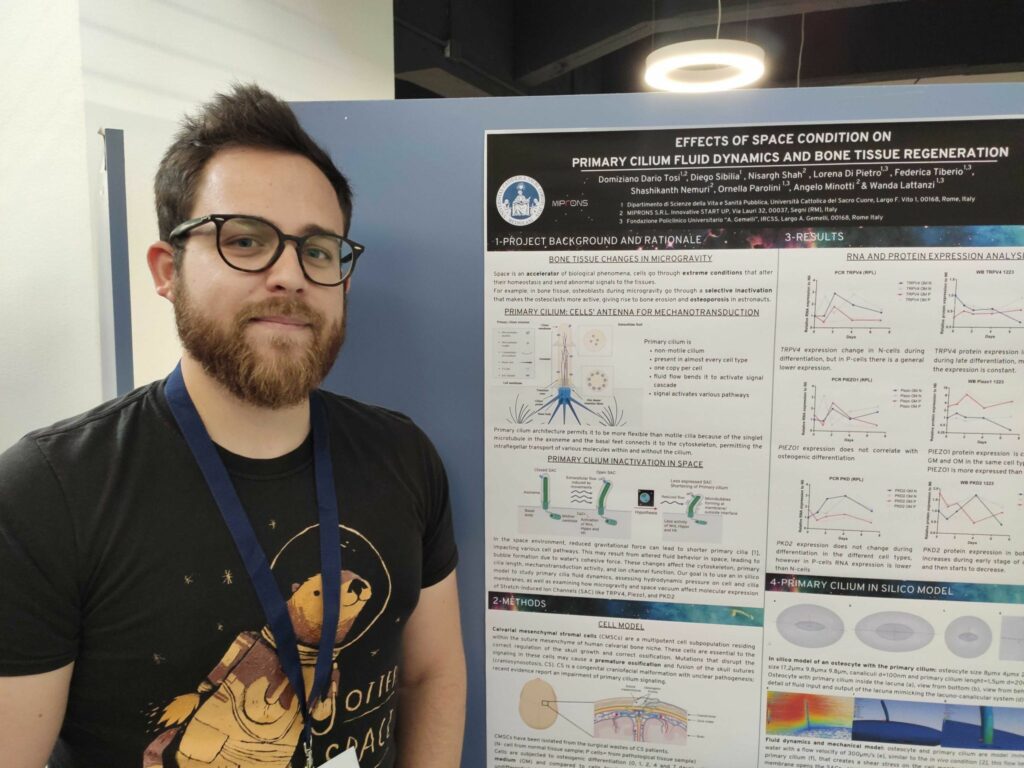MIPRONS, since last November 2022, is involved in a very special research, born from the collaboration with the Università Cattolica del Sacro Cuore and co-financed by the Regione Lazio. Together we financed the “RIGESTA” project (Studio della RIGenerazione tissutale in condizioni ESTreme: ruolo della microgravità e della pressione sull’omeostasi delle nicchie STAminali).
Dr Tosi presented his PhD project at EANA 2023, the conference of the European Astrobiology Network Association, held at the Universidad Carlos III de Madrid.
“It was a wonderful opportunity to get to know and enter the world of astrobiology. And a special thanks to my tutors prof. Wanda Lattanzi & prof. Angelo Minotti for supporting me in this journey”, said Dr Tosi after the presentation.
Microgravity is one of the extreme environmental conditions’ astronauts are exposed in space and is known to impair tissue homeostasis. As a protocol for all spacepeople, they must withstand a very intense training on a daily basis to reduce these effects, but it has been proven to be with small benefits. These effects are mostly due to altered mechanotransduction and above all can cause an accelerated progression towards osteoporotic and muscle degeneration. Therefore, space can be exploited as accelerators of illness processes occurring on earth.
Primary cilium (PC) is a microtubule-based thin organelle protruding from the plasma membrane that transduces mechanical signals acting on the cell surface; in fact, under the extracellular fluid dynamics, the PC bends causing the membrane to be stressed and stretch in the direction of the flow and then permitting the opening of specific stretch-induced ion channels (TRPV4, PKD2 and Piezo1), hence increasing intracellular Ca2+ concentration that activates several downstream pathways, like Hedgehog, Wingless related integration site (WNT) and Hippo (all important signaling pathways that regulates cell fate and cell proliferation).
This study aims to investigate the role of the PC and of altered mechanotransduction signaling, occurring in bone cells because of microgravity, with the final goal of finding molecular effectors and targets that can solve and modulate the space effects on the bones and at the same time exploring the influence of the weightlessness on the extracellular fluid dynamics.
To this aim, an integrated in silico/in vitro approach, merging aerospace engineering and molecular biology, is adopted. We have analyzed the expression of the mechanosensitive ion channels using qPCR and western blotting during osteogenic differentiation of human mesenchymal stromal cells.
Our results showed that the expression of TRPV4 increases during osteogenic differentiation, PKD2 increases only at the early stage of differentiation, while PIEZO1 expression is not modulated. This suggests that TRPV4 and PKD2 expression is associated with mechanical stimulation occurring during mineralized matrix deposition, phenomena that in microgravity are altered and reduced. These outcomes were supported by numerical simulations addressing the fluid-structure interaction of a 3D model designed to mimic the extracellular environment surrounding the PC.

